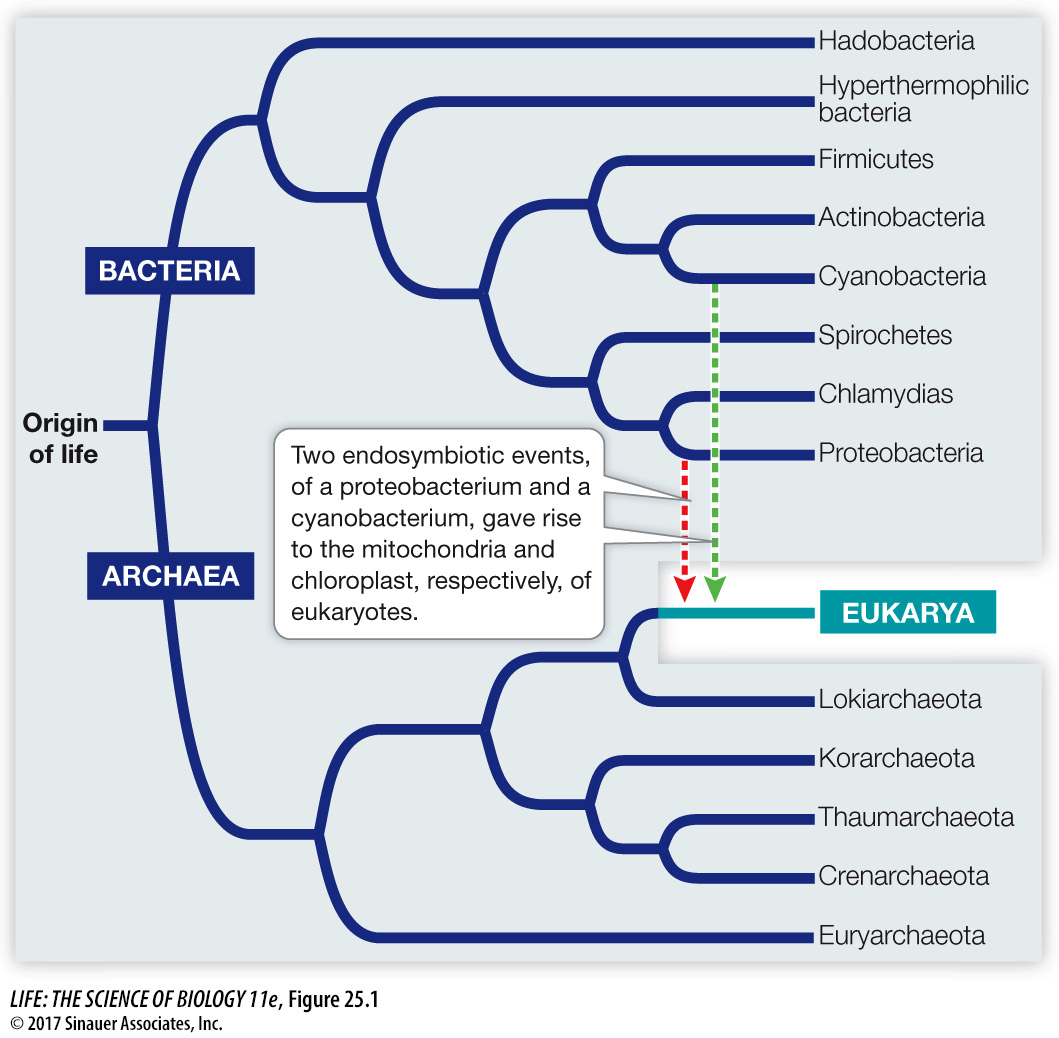key concept 25.1 Bacteria and Archaea Are the Two Primary Divisions of Life
529
You may think that you have little in common with a bacterium. But all multicellular eukaryotes—
have cell membranes and ribosomes (see Chapters 5 and 6).
have a common set of metabolic pathways, such as glycolysis (see Chapters 8 and 9).
replicate DNA semiconservatively (see Chapter 13).
use DNA as the genetic material to encode proteins, and use similar genetic codes to produce those proteins by transcription and translation (see Chapter 14).
These shared features support the conclusion that all living organisms share a common ancestor. If life had multiple origins, there would be little reason to expect all organisms to use overwhelmingly similar genetic codes or to share structures as distinctive as ribosomes. Furthermore, similarities in the DNA sequences of genes that are shared by all organisms confirm the monophyly of life.
focus your learning
Bacteria and prokaryotic archaea share some features and differ in others.
Some groups of bacteria can be distinguished based on the Gram stain.
Lateral gene transfer can lead to discordant gene trees.
Although all living things share many features, major differences have evolved across the diversity of life. Biologists have now sequenced the genomes of many living organisms, and these genomes allow us to reconstruct the details of evolutionary history. These studies clarify that there are two fundamental divisions of life: Bacteria and Archaea (Figure 25.1). Another major group evolved from within the Archaea: the Eukarya, which includes all plants, animals, and fungi.

Animation 25.1 The Evolution of the Three Domains
www.life11e.com/
When biologists speak of three major domains of life, they usually mean Bacteria, prokaryotic Archaea, and Eukarya. But if you examine Figure 25.1, you will see that eukaryotes evolved from within the prokaryotic Archaea. So in this sense, eukaryotes are a specialized group of Archaea that developed some important new features (including a cell nucleus) that allowed them to thrive. We call all the organisms that lack these specializations prokaryotes (Greek, “before the kernel,” or before the evolution of a cellular nucleus). Prokaryotes are clearly not all most closely related to one another, but the name “prokaryotes” is nonetheless a useful way of talking about all organisms that are not eukaryotes. In a similar manner, when most biologists talk about “archaea,” typically they are referring to just the prokaryotic Archaea.
All prokaryotic organisms are unicellular, although they may form large, coordinated colonies or communities consisting of many individuals. Eukaryotes, by contrast, include both unicellular as well as many multicellular life forms. As we saw in Chapter 5, prokaryotic cells differ from eukaryotic cells in some important ways:
Prokaryotic cells do not divide by mitosis. Instead, after replicating their DNA, prokaryotic cells divide by their own method, binary fission (see Key Concept 11.1).
The organization of the genetic material differs. The DNA of the prokaryotic cell is not organized within a membrane-
enclosed nucleus. DNA molecules in prokaryotes are often circular. Many (but not all) prokaryotes have only one main chromosome and are effectively haploid, although many have additional smaller DNA molecules, called plasmids (see Key Concept 12.6). Prokaryotes have none of the membrane-
enclosed cytoplasmic organelles that are found in most eukaryotes. However, the cytoplasm of a prokaryotic cell may contain a variety of infoldings of the cell membrane and photosynthetic membrane systems that are not found in eukaryotes.
530
Although the study and classification of eukaryotic organisms goes back centuries, much of our knowledge of the evolutionary relationships of prokaryotes is extremely recent. Not until the final quarter of the twentieth century did advances in molecular genetics and biochemistry enable the research that revealed the deep-